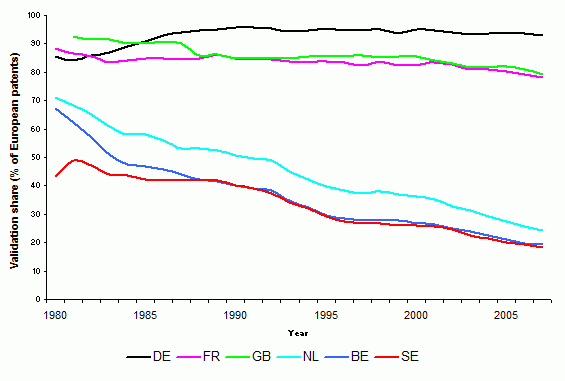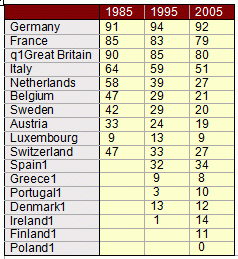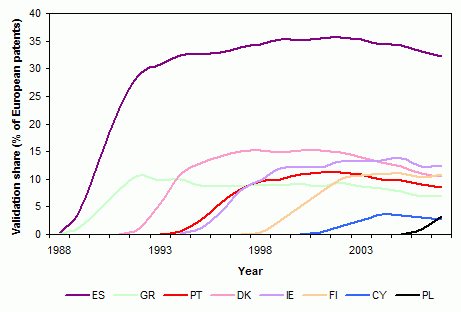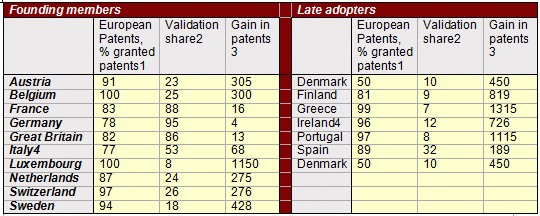In a couple of weeks the European Council will decide on the implementation of the EU patent. This is the last chance in the foreseeable future to overcome the deadlock in the negotiations on harmonising the patent law. Following the many objections to patent law reform in the past, this time Spain and Italy are demanding that EU patents be translated in Spanish and Italian, in addition to the three official European languages, English, French, and German.
Currently, a European patent is effectively a basket of national patents. Validation of a European patent in a country requires translation of the patent and payment of validation and renewal fees (Danguy and van Pottelsberghe 2010 and Harhoff et al. 2009). Not only does this make the present system expensive, but it also skews it in favour of large countries. The EU patent would replace the basket of patents with a single patent that is valid throughout the EU.
New data show that the share of European patents that are validated in the smaller member states of the EU is declining sharply. We argue that low validation rates reduce technological competition and make a country less attractive for foreign innovators. For these reasons, the EU patent would especially benefit smaller member states.
Falling validation rates
European patents are often not validated in smaller member countries. For example, in 2008 only 18% of the European patents have been validated in Sweden, and just 24% have been validated in the Netherlands. The proportion of European patents that are protected in smaller member states has been declining at a steady pace.
Figure 1 shows the evolution of validation shares for six of the nine founding members of the European patent Convention. Typically, smaller countries experience a substantial decrease in validation shares, while the shares of large economies have remained approximately constant. Validation shares in the Netherlands, Belgium, Sweden, and Austria (not in figure) seem to converge towards a validation share around 20%. Luxembourg (not in figure) is the only smaller early member state showing a constant validation share, with a temporary increase in the early 1990s. Statistics for more members can be found in Table 1.
Figure 1. Validation shares for selected founding member
Figure 2 shows the validation shares of late adopters of the covention. All countries except Poland converge towards a more or less constant validation share. In Spain, from 1993 onwards approximately 30% of the European patents have been validated. For Greece, Portugal, Denmark, Ireland, Finland and Cyprus the share is between 8% and 13%. The majority of late adopters have relatively low validation rates compared to the founding members. Spain is the only late adopter that has achieved a higher validation rate than Belgium, the Netherlands, and Sweden.
Table 1. Evolution of validation shares (% of newly granted European patents)
1 Spain and Greece entered the European patent Convention in October 1986, Denmark in January 1990, Portugal in January 1992, Ireland in August 1992, Finland in March 1996 and Poland in March 2004
Figure 2. Validation shares for selected late adopters
European patents dominate in small countries
European patents are more important than national patents in most European countries. The first column of Table 2 shows the share of European patents in all newly granted patents. In the four largest countries the share of European patents is about 80%, while the share typically exceeds 90% in the other founding states. Most late adopters (right panel) also heavily rely on European patents. Finland and Denmark have relatively small shares of European patents – but they are still growing.
The second column displays the validation share of European patents for each country. Countries that have a low validation share systematically rely more heavily on European patents. Column three illustrates the hypothetical change in the total number of patents if the EU Patent would be implemented, assuming that the EU Patent would raise validation shares to 100%. Without exception, smaller member states will experience a dramatic increase in the total number of patents, exceeding 200%.
Table 2. Smaller member states have more to gain from an EU-patent
1 Percentage European patents of all newly granted patents in a particular country in 2008. 2 Validation share, expressed as percentage of granted European patents, in 2008. 3 The potential gain in granted patents when all European patents are validated in all its Member States. The gain is expressed in percentage of granted patents in a particular country in 2008. 4 For Italy and Ireland the most recent reliable statistics are from 2003 and 2000, respectively. Source: Authors’ own calculations based on the EPO patent databases PATSTAT and INPADOC.
Technological competition
Implementation of the EU patent will not only reduce the costs of protecting intellectual property, equally important is that it ascertains uniform legal protection across member states. A similar, but smaller, reform took place in the US with the formation of the Court of Appeals for the Federal Circuit in 1982. Galasso and Schankerman (2010) show that this US reform has substantially reduced the length of legal disputes and has sped-up licensing agreements. Their results imply that harmonisation of legal procedures will benefit innovative firms.
In Europe, low validation rates form large de facto differences in the protection of patents. Firms in smaller member states run only a small risk of infringing a patent as long as they do not operate in large countries. This promotes a climate of imitation rather than innovation. Adoption of the EU Patent will put an end to strategies based on imitation and will induce firms in small countries to be more innovative.
A second benefit of the EU patent is that it prevents strategic validation intended to avoid legal action by competitors. A firm might choose not to validate a patent in member states where a competitor is active. In this way, the firm reduces the probability that the competitor will oppose the patent at the European Patent Office. Incentives for minimising the probability of opposition are large; if the Patent Office decides to revoke the patent, then the patent will be declared invalid in all countries. This would be a severe setback for the patentee. The EU patent will make it harder for firms to geographically split up the market. By taking away the option of strategic validation, European firms will have to innovate faster to stay ahead of the competition.
Attractiveness to foreign innovators
When a part of a firm’s portfolio of European patents is not valid in a particular country, that country will be less attractive as a location for the firm’s production or sales activities. The crucial point here is the nine-month window during which patentees can decide on validation. After this period, the geographical scope of a patent cannot be extended. Therefore, firms are needlessly geographically bounded by their patent portfolio.
Introduction of the EU Patent will make it easier for firms to relocate their activities or to sell their patent portfolio to foreign firms. This improves the allocation of knowledge within the internal market and enhances the incentives for innovation—not only for European firms, but also for US and Japanese multinationals.
The decline in the validation rates of European patents in smaller member states is a distressing development. Low validation rates reduce technological competition in these countries and makes them unattractive for foreign firms with a portfolio of European patents. Implementation of the EU patent, with or without Italy and Spain, would be an important step forward in improving the European innovation environment.
References
Danguy J and B van Pottelsberghe de la Potterie (2010), “On the consequences of an EU patent for inventors and patent offices”, VoxEU.org, 14 July.
Galasso, A and M Schankerman (2010), “Patent Thickets, Courts and the Market for Innovation”, The RAND Journal of Economics, 41(3):472-503
Harhoff D, K Hoisl, B Reichl, and B van Pottelsberghe de la Potterie (2009), “Patent Validation at the Country Level – the Role of Fees and Translation Costs”, Research Policy, 38(9):1423-1437.





